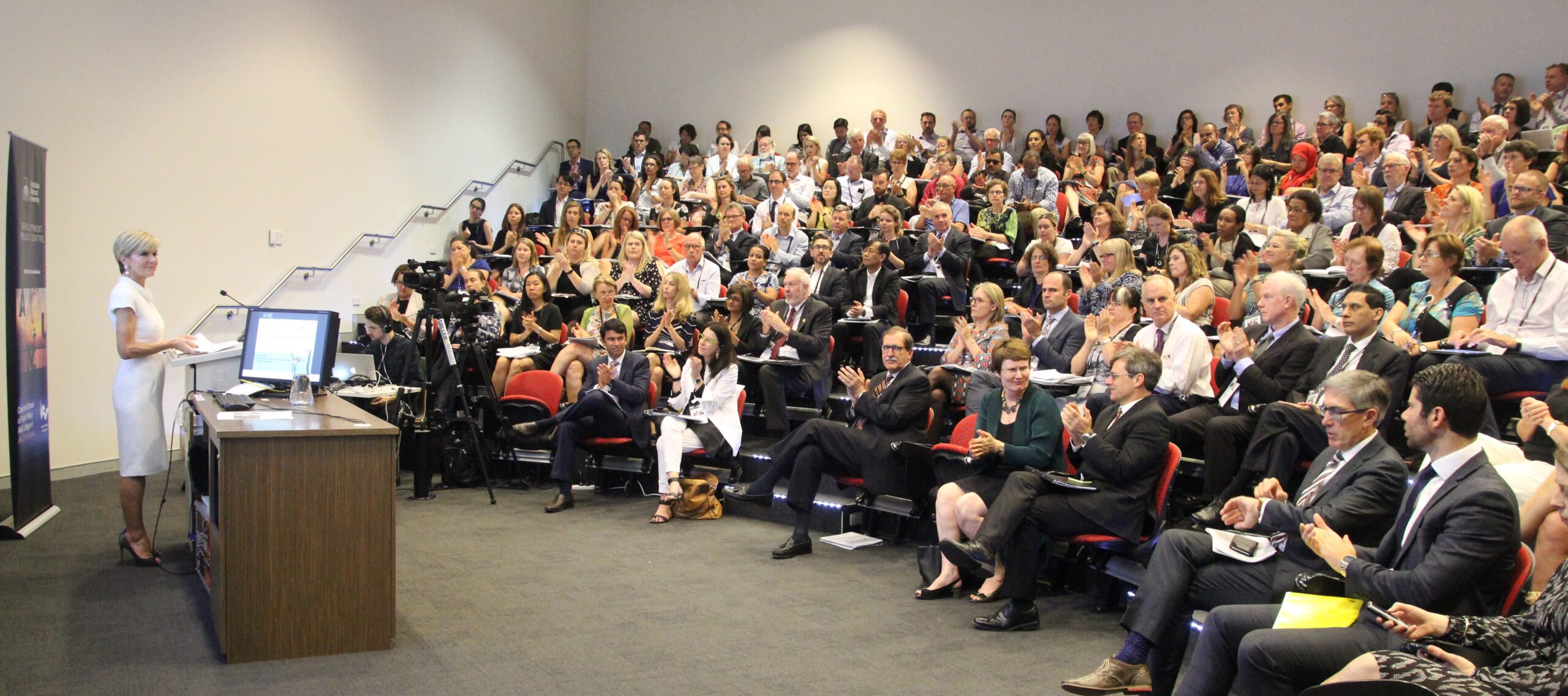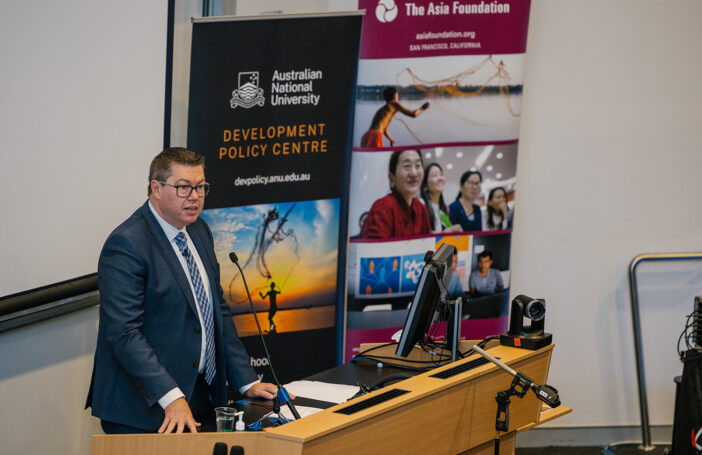Australia’s foreign minister, Julie Bishop, kicked off this year’s Australasian Aid Conference on February 15 and 16 with a reminder of the pressures facing international development today, and that “like other strands of globalization, our international aid sector must step up and explain – and re-explain, in clear and effective terms, why it is in our national interest, to support the development of developing countries.” Development is a global concern, she concluded, and the best, most sustainable solutions will come about through global cooperation.
This call to action rippled through lively discussions at the conference’s 30 panels and numerous side events. The event, held at The Australian National University’s Crawford School of Public Policy in Canberra in partnership with The Asia Foundation, has become the go-to regional forum on the latest trends and research in international development and aid policy, and this year attracted more than 500 participants from a dozen countries. Here are 9 key highlights from this year:
Foreign Minister Julie Bishop opens the conference and announces renewed funding for reproductive health
Minister Bishop opened the conference with bold statements on Australia’s foreign aid. Describing the Australian aid program as having too often been seen through “the outdated lens of some sort of benevolent charity” she advanced her vision of a program grounded in Australian national interest, engaging private sector partnerships, and countering violent extremism. She also reaffirmed the Australian aid program’s support of gender and women’s empowerment initiatives, including the announcement of a A$9.5 million replenishment to support sexual and reproductive health programs in humanitarian crises managed by the International Planned Parenthood Federation (IPPF) – a clear public statement which was interpreted by many as Australia’s response to the recent reinstatement of the Global Gag Rule.
Launch of the 2017 World Development Report: Governance and the Law
The World Bank launched its signature development report during the conference. The World Bank, which has long assumed an apolitical stance toward development, boldly asserts that “exclusion, capture, and clientelism are manifestations of power asymmetries that lead to failures to achieve security, growth, and equity.” The report provides the “ingredients but not the recipe” for governance programs to change elite incentives, reshape preferences, and reduce barriers to participation of marginalized groups. While this is approach is not new for organizations with a track record of thinking and working politically, the fact that it’s being prescribed by the World Bank presents both a sea change in World Bank analysis and a validation of ongoing efforts within the wider development community.
Building State Capability: Evidence, Analysis, Action
Michael Woolcock, lead development specialist with the World Bank’s Development Research Group, gave an engaging and fast-paced keynote address, arguing that while the world is getting better in terms of human development indicators, it is flat-lining when it comes to state capability, despite expanding funding for capacity building. The problem? We expect too much from institutions too soon. “You can’t juggle without the struggle” he said. He recommended more energy be devoted to helping institutions develop capability through practice. He introduced a process, Problem Driven Iterative Adaptation (PDIA), that governments can use to escape these capability traps. His new book, Building State Capability: Evidence, Analysis, Action, provides a practical guide to this new approach.
New program on Individual Deprivation Measure
In addition to the IPPF commitment, Minister Bishop formally launched a partnership between ANU and the International Women’s Development Agency to support the Individual Deprivation Measure (IDM), a new gender-sensitive measure of poverty. While the IDM is still under development, the prospect of being able to gather data which illuminates the differences in how poverty is experienced below the household level generated considerable excitement among conference attendees.
Private sector engagement in development cooperation, nothing new for Asia
Minister Julie Bishop also declared the private sector the most important driver of economic growth and poverty alleviation, and announced that Australia has a new strategy to implement this commitment. This isn’t new for Asian countries where private sector investment has been a pillar of their cooperation strategies for decades, but what is new is how Asian companies are making these investments more sustainable. A plenary panel featuring speakers from China, Korea, India, and Australia presented how Asian companies are acting more responsibly in their overseas activities by involving communities, drawing on core capabilities, and creating shared value. Indian pharmaceutical companies are providing HIV RNA drugs for patients in partner countries for $1 a day, while LG, Korea’s electronics giant, deployed mobile phones for the Ebola crisis and Nepal earthquake. Chinese companies, after facing conflicts over large-scale mining and resource extraction projects overseas, are now engaging local communities to improve the quality and sustainability of their investments.
Debating the relevance of the ADB
With the emergence of the Asia Infrastructure Investment Bank (AIIB) and the New Development Bank (NDB), there is pressure for the ADB to demonstrate its continuing relevance. Discussion of a new report, Strengthening the Asian Development Bank in the 21st Century, concluded that the ADB is still significant as a source of development finance in the region but needs to raise its game by: 1) giving more voice to regional members like China and India, in governance 2) reforming its graduation policy to include support to more developed Asian countries where challenges still exist, and 3) maintaining a poverty focus and resisting the urge to wind down concessional lending. Overall the report was warmly received, and credited for being one of the most comprehensive external reviews of the bank in its 50-year history, though some attendees expressed concerns about Australia’s role in the bank and how the report’s recommendations will be translated into operational implementation.
Three-Minute Aid Pitch
The 3-Minute Aid Pitch – a new plenary session format modeled after the popular 3 Minute Thesis competition – energized the conference. Nine speakers presented short and snappy pitches on topics ranging from social impact investment to human rights advocacy, followed by an audience vote for the most compelling idea. Development Policy Centre researcher Ashlee Betteridge scored the top spot with her witty call for more innovation and creativity in development communication.
How to fix humanitarian aid
Responding to demand for more attention to humanitarian aid, the 2017 conference featured a plenary with experts from academia, NGOs, and government, who discussed the future of humanitarian assistance after the World Humanitarian Summit held in May 2016. Panelists applauded the Summit’s commitment to multi-year commitments, localization, and cash programming in humanitarian situations, while questioning whether the Summit’s commitment to transcending the divide between humanitarian assistance and development will enable or inhibit a system which already struggles to deliver in acute conflict settings. They also debated the role of the military in humanitarian crisis, especially given that in many countries the military is the only capable responder.
New research on aid and evaluation
Several panels showcased new research on aid and examples of practice around aid effectiveness and evaluation. An analysis of nearly 40,000 newspaper articles from Australia, New Zealand, the UK, and the US illuminated patterns in reporting on foreign aid over the last 20 years. One study revealed that for every 1,000 articles published in Australian newspapers, only 1.6 mentions aid. Those attending a panel on aid measurement were galvanized by a call to action by Publish What You Fund CEO Rupert Simons: “If you produce data, publish it. If you have data, use it. If you don’t have data, demand it.”
In addition the conference featured several sessions on gender equality and labour mobility. Catch-up on livestreamed sessions from the conference here. PowerPoint presentations and podcasts of all the conference sessions will also soon be made available on the conference website.
Camilla Burkot is a Research Officer at the Development Policy Centre. Anthea Mulakala is The Asia Foundation’s Director for International Development Cooperation. Anthea and Camilla are co-convenors of the annual Australasian Aid Conference, alongside Stephen Howes and Joel Negin.
This post is published in collaboration with The Asia Foundation’s blog, In Asia.





